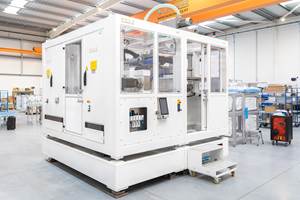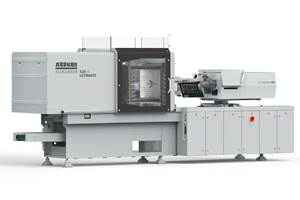Leading the Way in IML Packaging
Putting out the biggest volume of product isn't the only way to be a market leader, says Michael Spies, CEO of Spies Kunststoffe GmbH in Melle-Gesmold, Germany.
Putting out the biggest volume of product isn't the only way to be a market leader, says Michael Spies, CEO of Spies Kunststoffe GmbH in Melle-Gesmold, Germany. His firm specializes in injection molded packaging with in-mold labeling (IML). For this company, diverse technical capability is what makes it Germany's IML market leader and one of the premier specialists in Europe. It is also why U.S. firms want to emulate its success on their home turf, where the potential market for IML products is vastly bigger than in Western Europe.
Spies produces square, round, and rectangular containers and lids, as well as unusual package designs, including "wavy" rectangular shapes and octagonal or oval containers. Ice cream is the largest area of demand, followed by fine foods and diary products. All Spies' products are decorated in the mold with labels that may be flat or wrap-around, butterfly shape, or combination flat/split or wrap/flat. From single-sided to eight-sided labels and product sizes up to 6 liters are molded in tools with cavitation ranging up to 6 + 6 stack designs.
The firm produces 450 million to 550 million IML products a year, generating around $21 million in sales. "It is a mid-sized company," says Michael Spies, but its expertise helped it gain a leg up on a big North American IML contract with General Mills and prompted three molders from the U.S., where IML is in its infancy, to visit Spies's plant to evaluate its process and understand its approach. At first, Michael Spies generously accepted such visitors, but he now is more wary of nurturing competition in the States, where he is hoping to expand his business.
Keys to IML success
Family-owned Spies Kunststoffe started in 1964 as a moldmaking shop with 6800 sq ft of production area and 22 employees. Spies, like many European molders, saw the developing interest in IML and embarked on IML molding operations in 1967. Molding grew to require its own building by 1987.
"It is important to collect experience and know-how about the technology and market demands, and with that expertise it is then possible to create solutions. And it is also very important to know your limits and the limits of the technique," says Spies.
Spies began to focus its molding operations on packaging 10 years ago, and that focus has paid off with pioneering developments that set the company apart from its competitors. It pioneered in-mold labeling of two-compartment yogurt containers, a tricky job that involves wrapping two labels around two rotating dummy cores on robot end-of-arm tooling. The dummy cores advance and retract alternately to place the labels in the cavities. Spies has also learned to handle thinner labels, down to 50 microns, whereas the present standard is 75 microns. Thinner labels mean lower cost for the customer.
"We have had growth of 20% to 30% every year for the past four years," Spies says. Spies has grown to 160 employees and almost 55,000 sq ft of molding area. On the floor are 75 hydraulic presses from Swiss-based Netstal Machinery, ranging from about 265 to 550 tons. Sixty production cells produce IML products, and 20 of those cells use stack molds. Spies says a production cell making a 1-liter IML container in a four-cavity mold would cost around $1 million for the press, robot, mold, installation, and start-up.
Spies says a molder shouldn't count on operating an IML cell at peak efficiency. "We typically decrease the expected output of a production system by 10% due to frequent label changes, labels missed by the robot pick-up, maintenance on the machine and molds, line breakdowns, and other unforeseen circumstances."
Using molds with a modest number of cavities helps keep label and part handling manageable. "It is clear that raising the number of cavities makes it more difficult to guarantee a high-quality product and increases the risk of problems," Spies notes.
Side- and top-entry robots place labels in the molds and pull parts—sometimes simultaneously to save cycle time. Spies built extra flexibility into the proprietary automation system so as to permit handling different label shapes. "Robot suppliers have good knowledge about takeout systems. We mainly concentrate on the label-handling details—design of the magazine parts that hold the labels, vacuum grippers to pick up and deposit the label, dummy cores that hold the label, and so on. Those components we make on our own to a certain extent," says Spies.
Vision systems check for the presence of a label, correct label use, label registration, and part quality in-line with molding. Part counting, stacking and packaging are also automated.
Related Content
In-Mold Labeling Adjustment Head
Beck Automation says the new adjustment head targets production of small medical consumables packaging.
Read MoreKurz Opens New Plant in Vietnam
The maker of decorative thin films invested 37 million euros in the new 60,000-m2 plant in Quy Nhơn, which joins regional production facilities in China and Malaysia.
Read MoreBreaking News From NPE2024
Here is a firsthand report of news in injection molding, extrusion, blow molding and recycling not previously covered.
Read MoreIn-Mold Labeling Applied to Medical
In collaboration with multiple partners, Arburg will showcase IML for centrifuge tubes at Fakuma 2023, eliminating printing or other downstream steps.
Read MoreRead Next
See Recyclers Close the Loop on Trade Show Production Scrap at NPE2024
A collaboration between show organizer PLASTICS, recycler CPR and size reduction experts WEIMA and Conair recovered and recycled all production scrap at NPE2024.
Read MoreLead the Conversation, Change the Conversation
Coverage of single-use plastics can be both misleading and demoralizing. Here are 10 tips for changing the perception of the plastics industry at your company and in your community.
Read MoreBeyond Prototypes: 8 Ways the Plastics Industry Is Using 3D Printing
Plastics processors are finding applications for 3D printing around the plant and across the supply chain. Here are 8 examples to look for at NPE2024.
Read More





















